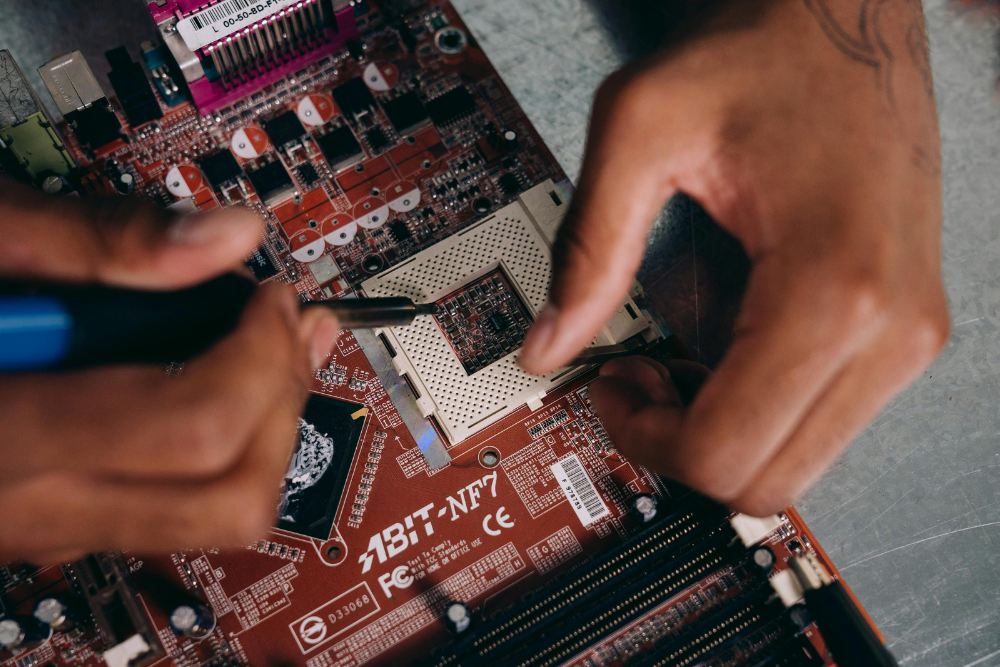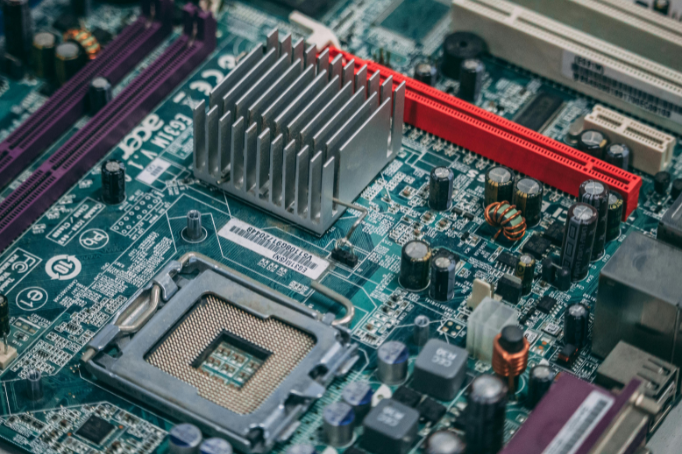As we can see today in the postmodern world, memory chipsets are basic building blocks towards the enhancement of several technological sectors. They are the foundation of electronic devices in providing data storage and processing platforms as well as data transfer. Memory chipsets are used in mobile phones, computers, server farms and a wide array of novel and emerging technologies such as AI, self-driving cars, and IoT. This blog explains how these memory chipsets affect technology innovation and the growth of different industries in the global technology economy.

Understanding Memory Chipsets
A memory chipset is a type of chipset that enables storage, processing and I/O control for memories of an electronic device. RAM, ROM, Flash memory and some other classifications are important for the given device’s functioning and have their pros and cons when used. RAM for example gives working space for the activities of processes whereas ROM contains basic system program instructions, and Flash memory is a type of non-volatile memory found in devices such as USB drives and SSDs. Both memory types are part of the framework that makes it possible for modern technology to execute advanced tasks effectively.
Driving Innovation in Technology
Memory chipsets are a critical element in the progression of the technological field. Since the devices being used are fast, small and powerful then there is a need for high-performing memory. DRAM and NAND flash memories, which enabled data storage and processing to be dynamic, have made important improvements. For instance, improvements in the DRAM load timings have enhanced applications handling efficiency, to help provide overall optimization in high-performing computing service delivery and gaming. In the same manner, NAND flash memory is crucial to the solid-state drive (SSD), which has accelerated data access than typical hard disk, hence strategic for high traffic usage.
These developments are particularly relevant for new technologies. In AI and machine learning, memory chipsets help to handle large datasets thus leading to the improved efficiency of AI algorithms. In self-driving automobiles, large and sophisticated memory structures are employed where the speed of the data processing and functioning is a decisive factor in the secure and smooth operation of the vehicle. As these sectors evolve, memory chipsets are still moving the goalpost forward in terms of what is possible.
Essential to the Global Technology Infrastructure
Memory chipsets are an integral part of almost every device that has any computational capacity. For mobile phones, computers and other devices, personal and organizational, as well as for major data centres, memory is one of the core factors for stable functioning. Internet and cloud computing infrastructure, the data centres that supply the technology, depend on these memory chipsets to access enormous amounts of data in a short period. Because of the increased adoption of cloud computing and big data applications, memory is ever expanding in capacity hence making memory chipsets critical props to the expansion and sustenance of digital infrastructure.
Also, the growth of 5G technology is driving demand for memory, where the relatively new standard allows devices to connect to the internet at greater speeds by also requiring more data to be processed and stored. Memory chipsets facilitate such enhanced data throughputs to be managed by the devices for asserted connectivity and service delivery. Consequently, memory technology plays an important role in the growth of the necessary digital platform for a networked and informational society.
Impact on Key Industries
The influence of memory chipsets extends across a wide range of industries, from consumer electronics and automotive to healthcare and finance.
Consumer Electronics
Memory chipsets are then used in consumer electronics as the need for increased performance and storage capacity is always on. For example, the operation of applications organized by smartphones, referencing multimedia documents, and multitasking depend on memory. The development of advanced memory chipsets for mobile phones has led to smartphones doubling up as potent computing tools capable of processing applications that hitherto needed a PC.
Automotive
Within the automotive industry, memory is critical for enabling ADAS, infotainment, and self-driving solutions. They also produce and manage huge data that need good memory retention to enable the overall system function. Per chipsets for memory enable real-time processing of data that propels the car’s reactions to the new conditions, thus improving safety and convenience.
Healthcare
Memory chipsets contribute significantly in healthcare by allowing storage and quick accessible medical information. For instance, the usual medical imaging devices like Magnetic Resonance Imaging or MRI and Computed Tomography or CT scanners use large amounts of memory to handle high picture resolution to produce results within a short time. Also, all the health apparel such as smart watches which are used to oversee patient health status and the signals from their bodies use memory to store and forward data to the patient’s doctors for better and frequent health attention and checkups.
Financial Services
In finance, a memory chipset supports quantitative trading, analytical reporting and risk management. Payments involve the need for quick processing of numbers and volumes of data which cannot be done without optimal memory facilities. Memory technology helps the financial institution manage the large amounts of data that are collected daily, process large volumes of data using complex algorithms and adapt to market changes within the shortest time possible since speed is the key determinant of success in the financial market.
Economic Significance of Memory Chipsets
Memory chipsets have great economic significance all over the world. The volume of the global memory market is in the hundreds of billions of dollars, and the struggle between leaders is candidates for the United States, South Korea, Japan, and China. These memory chipsets form significant value to the growth of the economy through employment, promotion of research activities as well as increased revenues in many industries.
Employment and Innovation
The things that memory chipsets produce are employment in engineering, manufacturing, research, and sales. Samsung has vast RC processes for new memory technology, and hence, it needs the skilled labour power of SK Hynix and Micron. Further, such companies continue to allocate significant amounts to research and development to support other sectors within the technology industry.
Export and Trade
Memory chipsets are considered a major export product, especially for countries with robust semiconductor sectors. For instance, South Korea has become one of the largest exporters of memory products having a substantial share in the country’s GDP. Due to the high demand for memory products worldwide, memory products are considered to be strong cash crops that help expand the economies of countries that manufacture memory products.
Strategic Importance
The memory chipsets also have a geopolitical significance to a nation on the global map. Consequently, it has dawned on various nations to seek assured sources of memory as demand spirals. This in turn has brought about a massive interest in local manufacturing of semiconductors and memory technologies, especially in the US, Europe and now China. Memory chipsets are no longer merely a technology; memory chipsets are strategically important to nations.

Challenges in the Memory Industry
While memory chipsets are vital to the tech economy, the industry faces challenges that could impact its growth.
Supply Chain Disruptions
The overall memory industry is primarily a manufacturing-dependent high-tech assembly industry that has a large global supply chain network which can be often vulnerable to disruptions. Darloos etc are likely to make the supply of raw materials quite unpredictable due to natural disasters, trade restrictions, and pressures resulting from political tensions that are likely to slow down or even hike the prices of raw materials. For example, COVID-19 which impacted the global supply chain of semiconductors underlined the necessity for more domestic production solutions.
Environmental Concerns
Memory chipsets are also a highly material process, demanding significant quantities of water, energy and scarce metals. Where the demand for memory is concerned, it also leads to the environmental cost. Currently, many memory manufacturers have started using environmentally friendly approaches in their operations but the market still has challenges enhancing growth while at the same time working hard to minimize the effect on the natural environment.
Technological Limitations
It has been seen that the advancements in memory innovation are constrained by physical and technical factors. There are some challenges associated with scaling up memory density and performance, including heat production and power consumption. To overcome these limitations, there is a need for further research and development, especially for the new memory technologies such as ReRAM and STT-RAM that can address the problems of the existing memory types.
The Future of Memory Chipsets
In the future, the market of memory chipsets will still be growing because of the increasing advancement of new technologies. AI, quantum computing and IoT will need more effective and progressive memory solutions than what is presently in use. As a consequence, memory manufacturers are putting their money into new generation memory technologies which have promised increases in speed, density and efficiency.
Emerging Memory Technologies
New types of memory are being developed at the present time such as 3D NAND, MRAM, and ReRAM that are designed to eliminate current memory problems. These technologies help achieve higher density, lower power consumption, and higher speed and hence are suitable for high-end applications in artificial intelligence, fifth-generation networks and the future.
Decentralization and Edge Computing
With the continued emergence of new devices that access the Internet, there is a demand for distributed computing and storage. Micron will be involved in edge computing which processes data near the source to help reduce latency and bandwidth consumption and memory chip sets. These Internet of Things and other end-node systems need to have efficient and small memory to store and process data locally, giving birth to new memory solutions.
Conclusion
Memory chipsets are the building blocks of the global tech economy, driving advancement and economic progress in various sectors. They sustain the operations of routine devices, energize important structures, and foster innovation in rising technologies. This industry has a few issues and risks like supply chain and environmental issues, although the global memory industry continues to invest in the innovation and development of new memory technologies for the future.
Thus, as memory further develops, it will become even more a driving force for technology, economy, and society.
About The Author
Elena Tang
Hi, I’m Elena Tang, founder of ESPCBA. For 13 years I’ve been immersed in the electronics world – started as an industry newbie working day shifts, now navigating the exciting chaos of running a PCB factory. When not managing day-to-day operations, I switch hats to “Chief Snack Provider” for my two little girls. Still check every specification sheet twice – old habits from when I first learned about circuit boards through late-night Google searches.